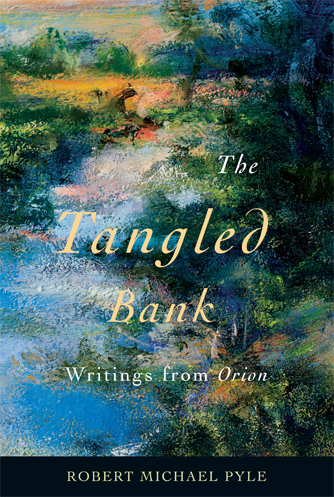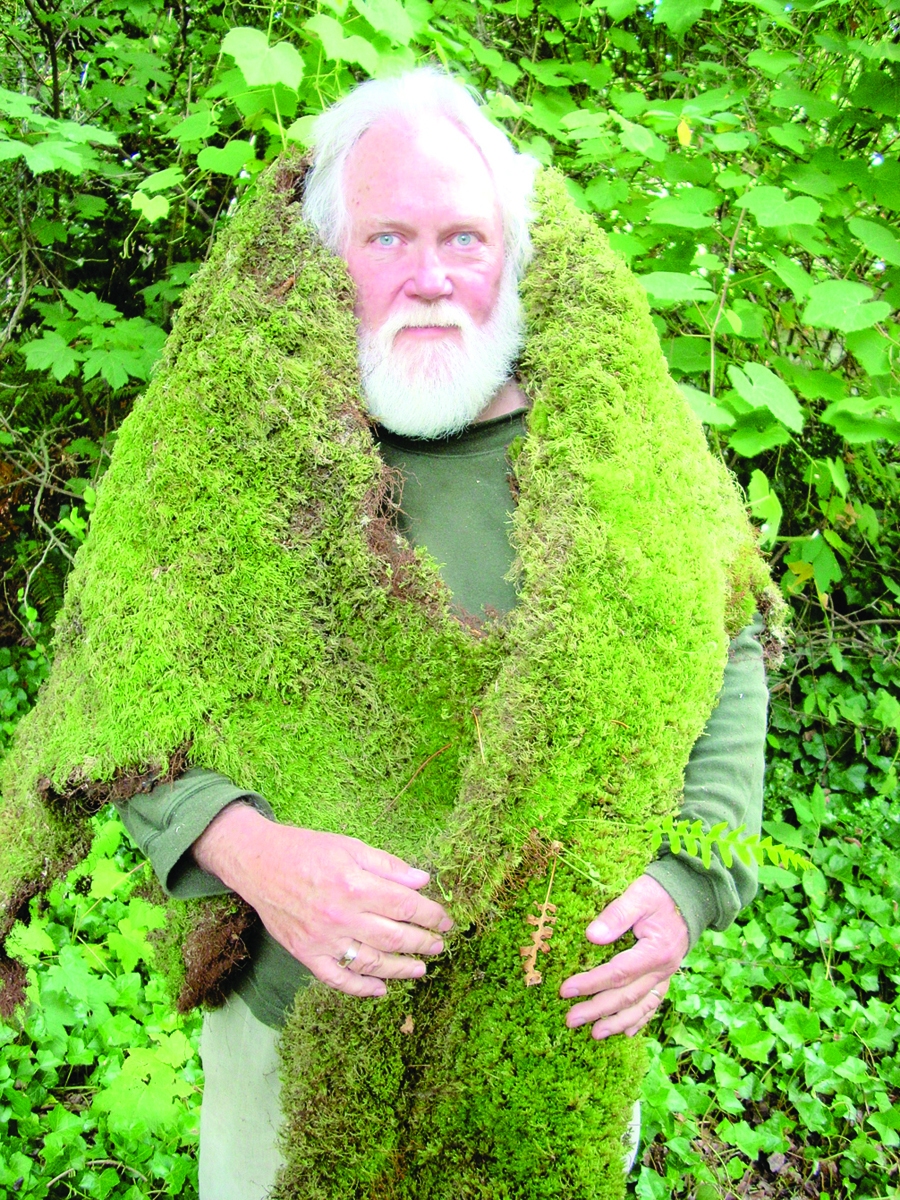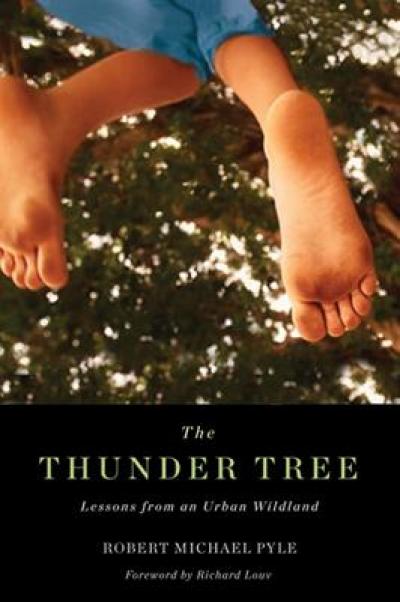 The first of our new fall books is here! Join us in celebrating the publication of The Tangled Bank in Corvallis on Thursday, Sept 27 and in Portland on Sunday, Sept. 30 (details below). Sharman Apt Russell calls Robert Michael Pyle's collection of essays from his popular "Tangled Bank" column in Orion and Orion Afield magazines "a deeply pleasurable read." We hope you enjoy the excerpt below.
The first of our new fall books is here! Join us in celebrating the publication of The Tangled Bank in Corvallis on Thursday, Sept 27 and in Portland on Sunday, Sept. 30 (details below). Sharman Apt Russell calls Robert Michael Pyle's collection of essays from his popular "Tangled Bank" column in Orion and Orion Afield magazines "a deeply pleasurable read." We hope you enjoy the excerpt below.
Leaves That Speak
I happen to live in a paradise of leaves. On the whole, the Pacific Northwest, and the maritime rainforest in particular, photosynthesize more with cedar scales and the needles of firs, hemlocks, and spruces than with full-blown, deciduous leaves. But this particular place is an old Swedish farmstead founded by an immigrant, by way of the Midwest, who cared more for horticulture than agriculture. Eventually he returned to Sweden, leaving the farm to dairy-herding descendants for the next seventy years until I came along. But before he sailed home, H. P. Ahlberg planted and nurtured a remarkable array of European, Midwestern, and native trees and shrubs, several of which are now the largest of their species in the state. The by-product of this fine arboreal legacy is a floristic melting pot of trees from many places reproducing together, a bastard ecosystem that coincidentally spawns, each spring, this paradise of leaves.
As I write, the furrowed broad blades of European hornbeams press toward my study window, overhung by the downy pink unfurlings of the greatest red oak’s leaves. The forest beyond grows daily more clogged with the many-greened vanes of English oaks, Swedish birches, and adventitious, exotic sycamore-maples, all growing in company with each native conifer that might be expected on such a site. Along the margins, the freshest spring greens of all express jointly in the luscious tissues of Eurasian beeches and native vine maples and the new growth of Sitka spruces. Then of course there is the panoply of form and verdure of the field layer, the understory, the ground plants, and the chaotic accumulations of more than a century of gardens.
When the people who were here before the Europeans first confronted bibles, books, and treaties, they could see that these strange new objects held great power for their colonial owners. Some of them referred to the black-marked pages as “talking leaves,” since they seemed to mediate speech as they turned in the wind like the leaves of trees. Sequoyah, a young Cherokee man, determined to provide his people with this power, which seemed to come from “making words fast on paper,” as he put it. Sequoyah proceeded to develop the only complete alphabet ever constructed by an individual. For this mammoth achievement, which resulted in rapid literacy among the Cherokee people, Sequoyah’s name was attached to the genus of the most massive trees in the world, the giant redwoods—trees whose own leaves are merely tight, overlapping scales.
The metaphor of the speaking leaf is a powerful one. Yet in our quickness to adopt comparisons, we sometimes forget to honor the original image upon which clever metaphors are built. While ours is a culture dramatically affected by printed pages every day—prattling pixels on our computer screens notwithstanding—we spend relatively little time attending to the actual objects: real leaves. Oh, we rake them, burn them, and mulch them in the fall; stand in their shade in torrid summertime; and watch our philodendrons twine around our windowframes, if we remember to water them. But how often do we go deliberately out-of-doors, especially to listen to the leaves speak?
My odd homeplace, rich as it is in botanical contradiction and the happenstance of growth, differs little from any other vegetated zone in the complexity of its conversation. The textures, flavors of green, progressions of season (those hornbeams will be October gold, those oaks, flagrant red rags), are only the accents. The leaves speak in the dialects of warblers, the whispers and growls of the wind, the minings, riddlings, and stridulation of insects, and the chemistry of their own compact with sun, soil, and water. The point is that wherever leaf comes from bud, grows, falls, and goes to ground, the colloquy is endless and endlessly nuanced; yet seldom really heard.
Sequoyah’s achievement was indeed large, and the dedication of redwoods in his name suitably proportioned—though he never saw such trees. Nor did his honor reach worldwide: in Britain, Sequioadendron gigantea trees are known as Wellingtonias, sharing the honor of being named after Lord Wellington with rubber boots. But I doubt Sequoyah would care. Besides inventing an alphabet, he knew a language that few of the owners of the new talking leaves could hear. Each of us could strive to learn that lingo, could go forth among the silent plants, to listen, to hear what we will, and to learn from the old talking leaves. Only then can the black-marked pages of books, of magazines, of this journal, find their fuller meaning.
Autumn 1997

Robert Michael Pyle dwells with his wife, Thea, a botanist and weaver, in an old Swedish farmstead in southwest Washington. His sixteen books include the John Burroughs Medal-winning Wintergreen, The Thunder Tree, Sky Time in Gray's River, and Mariposa Road. A Guggenheim Fellow and founder of The Xerces Society, he is often associated with butterflies, slugs, and Bigfoot.
Upcoming events
Thursday, Sept. 27 – 7 p.m. Old World Deli (241 SW 2nd St, Corvallis)
Launch celebration for The Tangled Bank and Thirty-Year Plan with Robert Michael Pyle and Orion editor Jennifer Sahn. Cosponsored by OSU Press, Spring Creek Project, and Grass Roots Books and Music
Sunday, Sept. 30 – 7:30 p.m. Audubon Society of Portland's Heron Hall (5151 NW Cornell Rd, Portland)
Launch celebration for The Tangled Bank and Thirty-Year Plan with Robert Michael Pyle and Orion editor Jennifer Sahn.
Monday, Nov. 5 – 7 p.m. Robert Michael Pyle at Powell's Books at Cedar Hills Crossing (3415 SW Cedar Hills Blvd, Beaverton)
Related Titles

The Tangled Bank
"It is interesting to contemplate a tangled bank, clothed with many plants of many kinds, with birds singing on the bushes, with various insects flitting...

The Thunder Tree
An engrossing memoir and eloquent portrait of place, The Thunder Tree shows how powerful the relationship between people and the natural world can be. “When...
